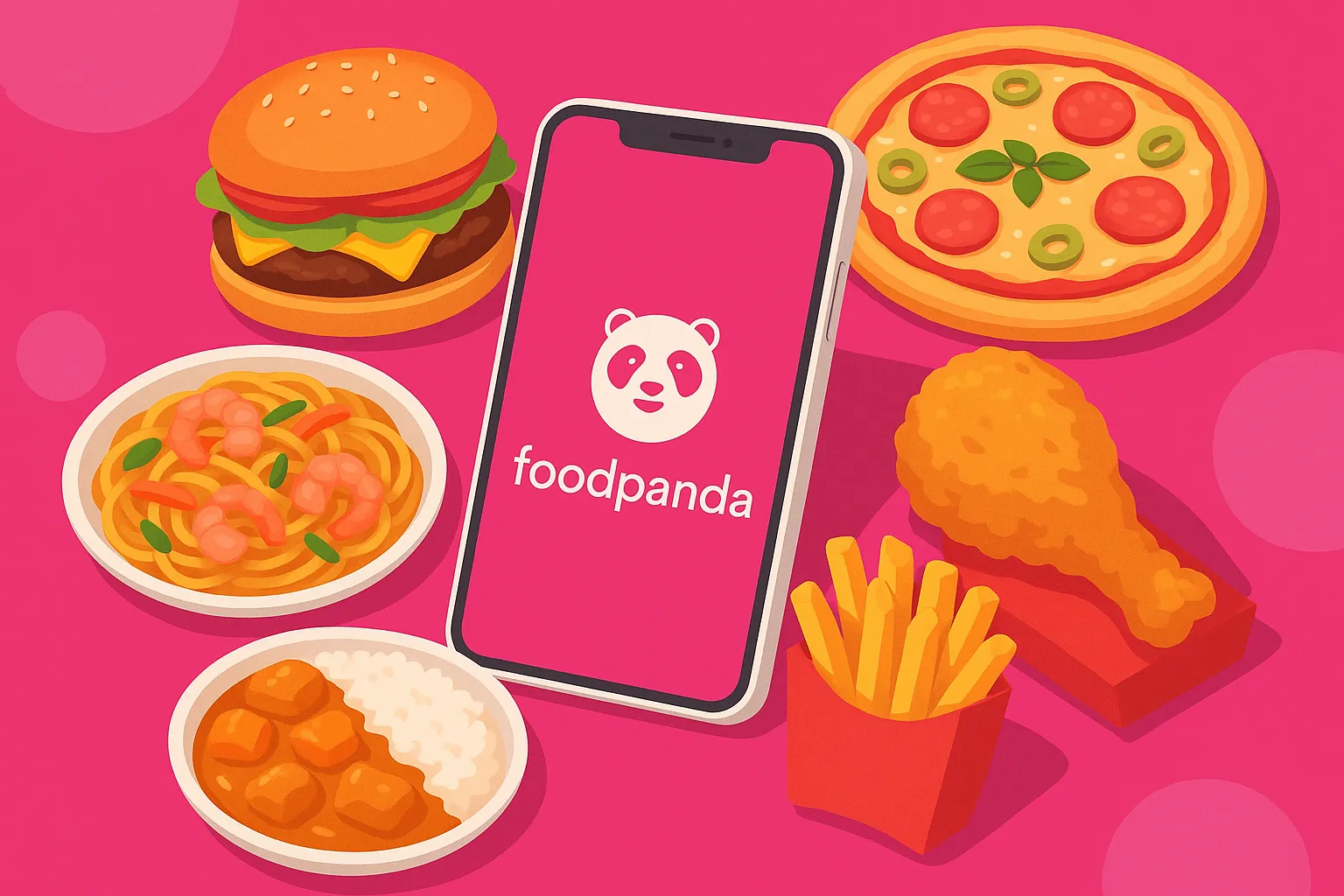Foodpanda has become a household name for anyone who enjoys the convenience of ordering meals straight to their doorstep. As one of the pioneers of online food delivery, foodpanda has built a business model that transformed how restaurants reach customers and how consumers experience dining.
Understanding the business model of foodpanda is essential for any startup founder aiming to launch a food delivery platform. From seamless logistics to multiple revenue streams, foodpanda’s strategy offers valuable lessons in scaling a marketplace app and sustaining profitability in a highly competitive industry.
What is foodpanda & How It Works
Foodpanda is an online food delivery platform that connects local restaurants with customers through its website and mobile app. Launched in 2012, it rapidly expanded across Asia, Europe, and the Middle East, becoming a go-to solution for quick, reliable meal delivery.
The Problem foodpanda Solves
Before apps like foodpanda, ordering food involved calling restaurants, navigating limited menus, and dealing with cash-only payments. Foodpanda solved this by:
- Aggregating restaurant menus in one place
- Offering transparent pricing and estimated delivery times
- Enabling cashless transactions
- Streamlining the ordering process with just a few taps
Who Uses It?
Foodpanda caters to:
- Busy professionals seeking convenient meal options
- Families ordering group meals
- Students and younger demographics comfortable with mobile ordering
- Small restaurants needing more visibility and a delivery channel
How the Platform Operates
The app functions as a two-sided marketplace:
- Customer Side: Users browse restaurants, add items to their cart, pay online or via cash on delivery, and track their order in real time.
- Restaurant Side: Restaurants receive orders through the foodpanda partner app or integrated POS system. They prepare the food and hand it over to delivery staff.
- Logistics Side: Foodpanda manages delivery via its fleet of riders or third-party couriers, ensuring food arrives promptly.
Read More : What is Foodpanda App and How Does It Work?
Target Audience
Foodpanda’s success lies in its ability to appeal to diverse customer segments while supporting restaurant partners and couriers. Here’s a closer look at who uses the platform:
1. Individual Consumers
- Urban Professionals: Busy office workers ordering lunch or dinner during hectic schedules
- Students: College and university students looking for affordable, fast meals
- Families: Parents ordering family-size portions for convenience
- Night Owls: Late-night diners and shift workers taking advantage of extended delivery hours
2. Restaurant Partners
- Small and medium-sized restaurants seeking an additional revenue channel
- Popular chains that want to expand delivery without investing in logistics
- Cloud kitchens operating exclusively online
3. Delivery Partners
- Independent riders and couriers who fulfill deliveries on a flexible schedule
By understanding these groups, foodpanda effectively tailors its app experience, promotions, and pricing to maximize engagement and loyalty.
Features that Support the Business Model
Foodpanda’s revenue and market dominance are powered by a robust feature set designed to attract customers, empower restaurants, and streamline delivery operations. Here are the core features that make it all work:
1. Restaurant Marketplace
A comprehensive directory of restaurants with detailed menus, ratings, and photos. This variety keeps customers coming back to explore new options.
2. Real-Time Order Tracking
Customers can track their orders step-by-step—from preparation to pickup to delivery—creating transparency and trust.
3. Seamless Payment Options
Multiple payment methods, including credit cards, digital wallets, and cash on delivery, reduce friction in checkout and boost conversion rates.
4. Smart Search & Filtering
Powerful search and filter tools let users find meals by cuisine, price, dietary preference, or delivery time.
5. Promotions & Loyalty Programs
Discount codes, referral bonuses, and loyalty rewards keep users engaged and encourage repeat orders.
6. Restaurant Management Dashboard
Partners can manage menus, adjust pricing, track orders, and analyze performance—all in one place.
7. Integrated Logistics & Delivery Management
Foodpanda’s rider app coordinates delivery assignments, optimizes routes, and provides live updates to restaurants and customers.
Read More : Top Foodpanda Features Every Food App Needs
Revenue Streams of foodpanda
Foodpanda generates revenue through a combination of commissions, delivery fees, and value-added services. This multi-pronged approach allows it to remain profitable while offering competitive pricing to users and partners.
Below is a clear breakdown of its revenue streams:
| Revenue Stream | How It Works |
| Commission from Restaurants | A percentage (usually 15–30%) charged on every order processed through the platform. |
| Delivery Fees | Fees charged to customers per order, sometimes dynamic based on distance or demand. |
| Advertising & Sponsored Listings | Restaurants pay to be featured prominently in search results and category pages. |
| Subscription Programs | Programs like “PandaPro” offer free deliveries and discounts for a monthly fee. |
| Service Fees | Additional fees applied during checkout to cover operational costs. |
| Data & Analytics Services | Insights sold to restaurant partners to improve menu and marketing strategies. |
Quick Explanations
- Commissions: The primary income source, earned from every sale.
- Delivery Fees: Encourage profitability on logistics while keeping base prices attractive.
- Advertising: Restaurants pay for visibility to drive more orders.
- Subscriptions: Creates predictable recurring revenue and boosts loyalty.
- Service Fees: Offset payment processing and customer support expenses.
- Analytics: Monetizes data by helping partners optimize their operations.
Read more : Revenue Model of Foodpanda: How the Food Delivery Giant Makes Money
Cost Structure
Running a food delivery platform like foodpanda requires managing a complex cost structure. Here are the main expenses that impact profitability:
1. Delivery Logistics
- Paying delivery riders (salaries, incentives, per-order fees)
- Fuel and vehicle maintenance (if operating a fleet)
- Insurance and rider safety equipment
2. Technology & Platform Maintenance
- App and website development
- Hosting infrastructure and cloud services
- Security and payment gateway fees
- Continuous updates and bug fixes
3. Customer Support
- 24/7 support teams for order issues and refunds
- Training and quality assurance for service agents
4. Marketing & Promotions
- Digital advertising campaigns
- Referral bonuses and discount coupons
- Loyalty program expenses
5. Restaurant Partner Support
- Onboarding and training costs
- Account management and relationship teams
6. Administrative & Compliance
- Office operations
- Legal, accounting, and regulatory compliance
- Data protection measures
These costs are substantial but essential to maintaining the high standards and smooth experience that users expect from foodpanda.
2024–2025 Innovations or Updates
Foodpanda has continued to evolve its business model to stay competitive and meet changing customer needs. Here are some notable updates and innovations shaping the platform in 2024–2025:
1. AI-Powered Personalization
Foodpanda has rolled out advanced machine learning algorithms to personalize:
- Restaurant recommendations
- Time-limited offers
- Re-order suggestions based on past behavior
This drives higher conversion rates and order frequency.
2. Sustainability Initiatives
To address environmental concerns, foodpanda has:
- Introduced eco-friendly packaging partnerships
- Allowed customers to opt out of cutlery by default
- Launched carbon offset options at checkout
3. Subscription Enhancements
The “PandaPro” subscription has been expanded to include:
- Free delivery on more restaurants
- Exclusive partner discounts
- Priority customer support
This helps secure recurring revenue and build loyalty.
4. Expanded Quick Commerce (“Q-commerce”)
Beyond restaurant food, foodpanda now delivers groceries and convenience items within 30 minutes in many cities, diversifying its revenue streams.
5. New Dynamic Pricing Models
Delivery fees are increasingly calculated using real-time demand, distance, and rider availability. This optimizes margins while balancing fairness for customers.
6. Enhanced Partner Analytics
Restaurants now get more granular data dashboards with insights on:
- Customer demographics
- Popular dishes
- Delivery heatmaps
These updates empower partners to improve operations and profitability.
Takeaways for Startup Founders
Building an app like foodpanda requires more than just a slick user interface. You need a thoughtful business model, reliable operations, and a plan to scale sustainably. Here are some lessons founders can learn from foodpanda’s journey:
1. Build a Strong Marketplace Foundation
Foodpanda’s core success comes from connecting a large base of restaurants and customers. Focus early on acquiring both sides of your marketplace. Incentivize restaurants to join by offering competitive commissions and marketing support.
2. Invest in Logistics Infrastructure
Efficient delivery is critical. Whether you build your own fleet or partner with third-party couriers, prioritize reliability and speed. Your reputation depends on timely deliveries.
3. Monetize Multiple Revenue Streams
Don’t rely only on commissions. Consider:
- Delivery and service fees
- Subscriptions (like PandaPro)
- Advertising placements for partners
- Selling insights and analytics
Diversifying income makes your business more resilient.
4. Embrace Technology and Data
Leverage AI and machine learning for:
- Personalized recommendations
- Demand forecasting
- Smart pricing
Data-driven decisions will set you apart in a crowded market.
5. Focus on Customer Experience
Loyal customers drive long-term success. Build trust with transparent tracking, responsive support, and seamless payments.
Why Work with Miracuves
At Miracuves, we specialize in helping founders launch ready-made food delivery apps that rival industry leaders. With our Food Delivery App Solutions and proven frameworks, you can:
- Go to market faster
- Save on development costs
- Focus on scaling your business
- Access ongoing support and feature updates
When you partner with us, you don’t just get code—you get the expertise behind successful platforms.
Conclusion :
Foodpanda’s business model shows how a thoughtfully designed marketplace can transform an entire industry. By combining strong logistics, smart monetization strategies, and relentless focus on user experience, foodpanda has set the standard for online food delivery.
If you’re an ambitious founder ready to build your own food delivery platform, Miracuves is here to help. We offer ready-made app solutions inspired by industry leaders like Foodpanda, Uber Eats, and DoorDash. Our experienced team will guide you through every stage—from customization to launch and beyond.
Ready to create your own success story?
contact with miracuves and see how fast you can bring your food delivery app idea to life.
FAQs :
1. How does foodpanda make money?
Foodpanda earns revenue mainly through commissions on every order, delivery and service fees charged to customers, advertising placements for restaurants, and subscription programs like PandaPro. This diversified approach helps maintain profitability even in competitive markets.
2. What percentage commission does foodpanda charge restaurants?
While it varies by region and partnership agreement, commissions typically range from 15% to 30% per order. Restaurants may also pay additional fees for featured listings or promotional placements.
3. Is foodpanda profitable?
Profitability depends on market conditions and scale. In many mature markets, foodpanda has achieved profitability by optimizing logistics, introducing subscriptions, and reducing operational costs. However, expansion into new regions can temporarily impact margins.
4. What technology does foodpanda use?
Foodpanda uses a combination of:
Real-time order tracking
Machine learning for personalization
Route optimization software for delivery riders
Secure payment gateways
Restaurant partner dashboards and APIs
These technologies work together to create a seamless experience.
5. How can I build a similar app?
If you’re interested in launching a food delivery platform like foodpanda, you don’t have to start from scratch. Miracuves offers ready-made food delivery app solutions you can customize to fit your vision, saving you months of development time and significant costs. Learn more about our food delivery solutions here.
Related Articles :
- Build a Food Delivery App Like ChowNow: Business Model, Features, and Costs
- How To Build a Food Delivery App Like Baemin: Features, Costs, and Development
- Key JustEat Features for Food Delivery Apps
- How to Make a Food Delivery App Like Deliveroo: Features, Costs, and Technology
- How to Develop a Food Delivery App Like Zomato: Features, Costs, and Timeline








